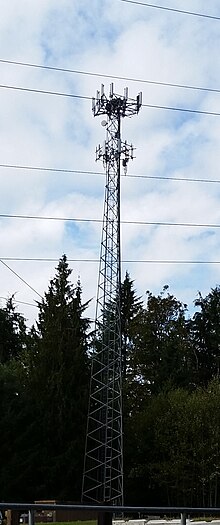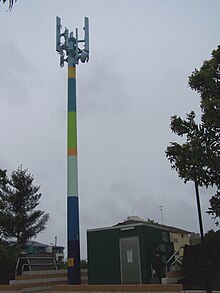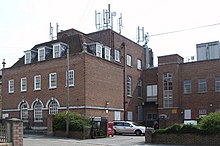Cell site









A cell site or cell tower is a cellular telephone site where antennae and electronic communications equipment are placed, usually on a radio mast, tower or other high place, to create a cell (or adjacent cells) in a cellular network. The elevated structure typically supports antennae, and one or more sets of transmitter/receivers transceivers, digital signal processors, control electronics, a GPS receiver for timing (for CDMA2000/IS-95 or GSM systems), primary and backup electrical power sources, and sheltering.[1][third-party source needed]
In Global System for Mobile Communications (GSM) networks, the correct term is Base Transceiver Station (BTS), and colloquial synonyms are "mobile phone mast" or "base station". The term "base station site" might better reflect the increasing co-location of multiple mobile operators, and therefore multiple base stations, at a single site. Depending on an operator's technology, even a site hosting just a single mobile operator may house multiple base stations, each to serve a different air interface technology (CDMA2000 or GSM, for example).
Some cities require that cell sites be inconspicuous, for example blended with the surrounding area,[2] for example mounted on buildings[3] or advertising towers.[citation needed] Preserved treescapes can often hide cell towers inside an artificial tree or preserved tree. These installations are generally referred to as concealed cell sites or stealth cell sites.
Operation
Range
The working range of a cell site (the range which mobile devices connects reliably to the cell site) is not a fixed figure. It will depend on a number of factors, including, but not limited to:
- Height of antenna over surrounding terrain (Line-of-sight propagation).
- The frequency of signal in use.
- Timing limitations in some technologies (e.g., GSM is limited to 35 km, with 70 km being possible with special equipment)
- The transmitter's rated power.
- The required uplink/downlink data rate of the subscriber's device [4]
- The directional characteristics of the site antenna array.
- Reflection and absorption of radio energy by buildings or vegetation.
- It may also be limited by local geographical or regulatory factors and weather conditions.
Generally, in areas where there are enough cell sites to cover a wide area, the range of each one will be set to:
- Ensure there is enough overlap for "handover" to/from other sites (moving the signal for a mobile device from one cell site to another, for those technologies that can handle it - e.g. making a GSM phone call while in a car or train).
- Ensure that the overlap area is not too large, to minimize interference problems with other sites.
In practice, cell sites are grouped in areas of high population density, with the most potential users. Cell phone traffic through a single site is limited by the base station's capacity; there is a finite number of calls or data traffic that a base station can handle at once. This limitation is another factor affecting the spacing of cell mast sites. In suburban areas, masts are commonly spaced 1–2 miles (2–3 km) apart and in dense urban areas, masts may be as close as ¼-½ mile (400–800 m) apart.
The maximum range of a mast (where it is not limited by interference with other masts nearby) depends on the same circumstances. Some technologies, such as GSM, normally have a fixed maximum range of 35 kilometres (22 mi), which is imposed by technical limitations. CDMA and IDEN have no built-in limit, but the limiting factor is the ability of a low-powered personal cell phone to transmit back to the mast. As a rough guide, based on a tall mast and flat terrain, it is possible to get between 50 to 70 km (30–45 miles). When the terrain is hilly, the maximum distance can vary from as little as 5 kilometres (3.1 mi) to 8 kilometres (5.0 mi) due to encroachment of intermediate objects into the wide center fresnel zone of the signal.[5] Depending on terrain and other circumstances, a GSM Tower can replace between 2 and 50 miles (80 km) of cabling for fixed wireless networks.[6]
Channel reuse
The concept of "maximum" range is misleading, however, in a cellular network. Cellular networks are designed to support many conversations with a limited number of radio channels (slices of radio frequency spectrum necessary to make one conversation) that are licensed to an operator of a cellular service. To overcome this limitation, it is necessary to repeat and reuse the same channels at different locations. Just as a car radio changes from one local station to a completely different local station with the same frequency when you travel to another city, the same radio channel gets reused on a cell mast only a few miles away. To do this, the signal of a cell mast is intentionally kept at low power and in many cases tilted downward to limit its reach. This allows covering an area small enough not to have to support more conversations than the available channels can carry. Due to the sectorized arrangement of antennas on a tower, it is possible to vary the strength and angle for each sector depending on the coverage from other towers in the area.
Signal limiting factor
A cellphone may not work at times because it is too far from a mast, or because the phone is in a location where cell phone signals are attenuated by thick building walls, hills, or other structures. The signals do not need a clear line of sight but greater radio interference will degrade or eliminate reception. When many people try to use the cell mast at the same time, e.g. during a traffic jam or a sports event, then there will be a signal on the phone display but it is blocked from starting a new connection. The other limiting factor for cell phones is the ability to send a signal from its low powered battery to the cell site. Some cellphones perform better than others under low power or low battery, typically due to the ability to send a good signal from the phone to the mast.
The base station controller (a central computer that specializes in making phone connections) and the intelligence of the cellphone keeps track of and allows the phone to switch from one mast to the next during conversation. As the user moves towards a mast it picks the strongest signal and releases the mast from which the signal has become weaker; that channel on that mast becomes available to another user.
Geolocation
Cellular geolocation is less precise than by GPS, but it is available to devices that do not have GPS receivers and where the GPS is not available. The precision of this system varies and is highest where advanced forward link methods are possible and is lowest where only a single cell site can be reached, in which case the location is only known to be within the coverage of that site.
An advanced forward link is where a device is within range of at least three cell sites and where the carrier has implemented timing system use.
Another method is using angle of arrival (AoA) and it occurs when the device is in range of at least two cell sites, produces intermediate precision. Assisted GPS uses both satellite and cell phone signals.
In the United States, for emergency calling service using location data (locally called "Enhanced 911"), it was required that at least 95% of cellular phones in use on 31 December 2005 support such service. Many carriers missed this deadline and were fined by the Federal Communications Commission.[7]
Radio power and health
The U.S. government agency, the FCC, says:
"For example, measurement data obtained from various sources have consistently indicated that "worst-case" ground-level power densities near typical cellular towers are on the order of 1 µW/cm2 or less (usually significantly less)." [8]
Cell phones, cell towers, wi-fi, smart meters, DECT phones, cordless phones, baby monitors and other wireless devices all emit non ionizing radio frequencies, which the World Health Organization (WHO) has just classified as a potential carcinogen. It should be noted however that this is classified as limited evidence available for carcinogenicity, which by definition states "chance, bias or confounding could not be ruled out with reasonable confidence." [9]
Cindy Sage, co-editor of the Bioinitiative Report writes, " The WHO International Agency for Research on Cancer has just issued its decision that non-ionizing radiofrequency radiation is classified as a 2B (Possible) Carcinogen. This is the same category as DDT, lead, and engine exhaust. This mirrors the 2001 IARC finding that extremely low frequency (ELF-EMF) that classified as a 2B (Possible) Carcinogen. This pertained to power frequency (power line and appliance) non-ionizing radiation. These two findings confirm that non-ionizing radiation should be considered as a possible risk factor for cancers; and that new, biologically-based public safety standards are urgently needed. " Dr. Louis Slesin has been reporting on this issue for decades.[10]
Temporary sites


Although cell antennas are normally attached to permanent structures, carriers also maintain fleets of vehicles, called cells-on-wheels (COWs), that serve as temporary cell sites. A generator may be included for use where network electrical power is not available, and the system may have a wireless backhaul link allowing use where a wired link is not available.
COWs are also used at permanent cell sites—as temporary replacements for damaged equipment, during planned outages, and to augment capacity such as during conventions.
Employment
Cell site workers are called tower climbers or transmission tower workers. Transmission tower workers often work at heights of up to 1,500 feet, performing maintenance and repair work for cellular phone and other wireless communications companies.
Spy agency setup
According to documents leaked to Der Spiegel, the NSA sells a $40,000 "active GSM base station" to be used as a tool to mimic a mobile phone tower and thus monitor cell phones.[11]
In November 2014, the Wall Street Journal reported that the Technical Operations Group of the U.S. Marshals utilizes spy devices, known as "dirtboxes", to mimic powerful cell tower signals. Such devices are designed to cause mobile phones to switch over to the tower, as it is the strongest signal within reach. The devices are placed on airplanes to effectively create a "dragnet", gathering data about phones as the planes travel above populated areas.[12][13]
Off-grid systems
This section needs additional citations for verification. (April 2012) |
An off-grid cell site is not connected to the public electrical grid. Usually the system is off-the-grid because of difficult access or lack of infrastructure.
Fuel cell or other backup power systems are added to critical cell sites to provide emergency power. More sites use internal-combustion-engine-driven generator sets.[14][15]
However, being less efficient than public power, they increase operating expense and are a source of pollution (atmospheric, acoustic, etc.) and some are in areas protected by environment and landscape conservation.
Renewable sources, such as solar power and wind power may be available where cell sites are placed. They can be backed up by a fuel generator system which allows the cell site to work when the renewable sources are not enough. One such energy production system consists of:
- Solar power generator
- Wind generator
- Electro-chemical generator fuel cells
Electrical energy from intermittent sources is stored in secondary batteries which are usually designed to have an average of 5 days of self-sufficiency, to allow time for maintenance personnel to arrive at site when a repair is needed.
The renewable energy systems supply electrical power when available. The fuel cells are activated only when the natural sources are not enough to supply the energy the system needs. The emergency power supply (the fuel cells) is designed to last an average of 10 days. In this way the structure is completely self-sufficient: this enables the maintenance team to pay only few visits to the site, since it is usually hard to get to.
Camouflage
There is often local opposition to new masts for reasons of safety and appearance. The latter is sometimes tackled by disguising the mast as something else, such as a flag pole, street lamp, or a tree (e.g. palm trees, pine trees, cypress..) or rooftop structures or urban features such as chimneys or panels.
These concealed cell sites can distinguish themselves by foliage shape and bark type. The foliage of all these antennas is composed of leaves made of plastic material accurately designed, taking into consideration quantity, shape and array suitable to completely conceal the antennas and all accessory parts in a natural manner. The materials used guarantee absolute radio-electric transparency and resistance to UVA rays. Nicknames include "monopalm" for a monopole disguised as a palm tree or "Pseudopinus telephoneyensis" for a mast disguised as a pine tree.[16] In monopoles, the directional antennas are sometimes hidden in a plastic housing near the top of the pole so that the crossbars can be eliminated.
Rooftop structures such as concealment chimneys or panels, 6 to 12 meters high, may conceal one or more mobile telephone operators on the same station. Roofmask panels can be fixed to existing rooftop structures, restyling them quickly and cheaply.
Mobile telephone base stations are becoming a contemporary symbol, connected and intertwining with material and immaterial networks. Telestyles are architecturally blended cell towers, the result of cooperation with designers and architects.
Miniature
Researchers at Alcatel-Lucent have developed a cell site called lightRadio that fits in the palm of a person's hand. It is the size of a Rubik's cube. It is capable of relaying 2G, 3G and 4G signals. They are more energy efficient and deliver broadband more efficiently than current cell sites. They could be used in very populated urban areas to make room for more radio space.[17]
See also
- Cellular network
- Node B
- OpenBTS
- Mobile phone radiation and health
- Telecom infrastructure sharing
- Base transceiver station
- Radio masts and towers
- Mobile cell sites
- Distributed antenna system
- Telecommunications lease
- Title 47 of the Code of Federal Regulations
- In re Application of the United States for Historical Cell Site Data
- Tower climber
References
- ^ "Learn about what is on a cell tower: Without the Cat". Retrieved 9 December 2010.
- ^ http://www.nytimes.com/2004/07/11/nyregion/the-girded-the-bland-and-the-prickly.html
- ^ http://www.nytimes.com/2010/08/21/nyregion/21celltower.html?_r=0
- ^ J. Andrews, A. Gohsh (2007). Fundamentals of WiMAX, p. 43
- ^ Frequently Asked PCS Questions undated, URL retrieved 14 August 2007. Archived 2006-05-09 at the Wayback Machine
- ^ NTIA Seeks Input on Broadband Stimulus Money undated, URL retrieved 3 March 2009. Archived 2009-11-22 at the Wayback Machine
- ^ http://www.fiercewireless.com/story/sprint-alltel-usc-fined-missed-e911-deadline/2007-08-31
- ^ Questions and Answers about Biological Effects and Potential Hazards of Radiofrequency Electromagnetic Fields Fourth Edition. FCC. August 1999. Page 21. Retrieved 7 April 2013
- ^ [1] Retrieved 20 October 2014
- ^ EMF Safety Network Retrieved 8 July 2014
- ^ Shopping for Spy Gear: Catalog Advertises NSA Toolbox, Dec 2013
- ^ Devlin Barrett (13 November 2014). "Americans' Cellphones Targeted in Secret U.S. Spy Program: Devices on Planes that Mimic Cellphone Towers Used to Target Criminals, but Also Sift Through Thousands of Other Phones". Wall Street Journal. Retrieved 14 November 2014.
- ^ Kate Knibbs (13 November 2014). "WSJ: A Secret U.S. Spy Program Is Using Planes to Target Cell Phones". Gizmodo. Retrieved 14 November 2014.
- ^ Ballard fuel cells to power telecom backup power units for motorola
- ^ India telecoms to get fuel cell power
- ^ http://www.watsonia.org.uk/BSBINews80.pdf
- ^ The tiny cube that could cut your cell phone bill, CNN Money, 21 March 2011, David Goldman
External links
- Maps of All Towers Across the United States
- Maps of All Towers Across the United Kingdom
- Maps of All Towers Across Canada
- Searchable map of cell (and all other) towers in Australia
- FCC: Universal Licensing Information
- FCC: Information On Human Exposure To Radio frequency Fields From Cellular and PCS Radio Transmitters
- Australian Radiation Protection and Nuclear Safety Agency (ARPANSA) Base Station Survey 2007- 2011
